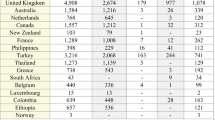Abstract
The Great War and the Russian revolution brought about a total collapse and disintegration of three European empires (Romanov, Habsburg, Ottoman) and the replacement of a fourth dynastical empire, Germany, with a parliamentary democracy. As their government structures were dismantled and armies demobilized, most of the newly formed nation-states that emerged in the vast post-imperial shatterzone stretching from the Elbe River to the Black Sea entered into new military conflicts. During 1918–20, Finland, Estonia, Latvia, Lithuania, Russia, Poland, Ukraine, Hungary and Romania plunged into a series of new post-imperial wars. These conflicts have been variously described, depending on one’s perspective, as ‘civil wars’, ‘freedom fights’ or ‘liberation struggles’. Until today they are largely perceived and commemorated in national contexts. Yet it is long overdue to examine them as a single all-European phenomenon.1
Access this chapter
Tax calculation will be finalised at checkout
Purchases are for personal use only
Preview
Unable to display preview. Download preview PDF.
Similar content being viewed by others
Notes
A new comparative approach to various post-World War I European conflicts was recently proposed by: Robert Gerwarth, ‘The Central European Counter-Revolution: Paramilitary Violence in Germany, Austria and Hungary after the Great War’ Past & Present, 200 (2008), pp. 175–209.
See also: Alexander V. Prusin, The Lands Between: Conflict in the East European Borderlands, 1870–1992 (Oxford, 2010), particularly chapter 3.
In the case of Lithuania, some typical works in this category are: Kazys Ališauskas, Kovos dėl Lietuvos nepriklausomybės, 1918–1920 (Chicago, 1972);
Jonas Aničas, Generolas Silvestras Žukauskas, 1861–1937 (Vilnius, 2006);
Vytautas Lesčius, Lietuvos kariuomenėnepriklausomybės kovose, 1918–1920 (Vilnius, 2004).
Juliette Cadiot, ‘Russian Army, Non-Russians, Non-Slavs, Non-Orthodox: The Risky Construction of a Multiethnic Army. Russia, USSR’ Journal of Power Institutions in Post-Soviet Societies, 10 (2009), p. 2.
Joshua A. Sanborn, Drafting the Russian Nation: Military Conscription, Total War, and Mass Politics, 1905–1925 (DeKalb, IL, 2003), p. 75.
Geoffrey Swain, ‘The Disillusioning of the Revolution’s Praetorian Guard: The Latvian Riflemen, Summer-Autumn, 1918’ Europe-Asia Studies, 51, no. 4 (June 1999), p. 671.
Vytautas Lesčius, Lietuvos kariuomenė, 1918–1920 (Vilnius, 1998), p. 19.
Petras Ruseckas (ed), Savanorių žygiai, vol. 1 (Vilnius, 1991), p. 6.
John Erickson, The Soviet High Command: A Military-Political History, 1918–1941 (London, 1962), p. 16.
Peter Gatrell, Russia’s First World War: A Social and Economic History (Harlow, 2005), p. 232.
Norman Davies, White Eagle, Red Star: The Polish-Soviet War 1919–20 and ‘the Miracle on the Vistula’ (London, 2003), p. 87.
Aldona Gaigalaitė, ‘Sovetsko litovskie voinskie formirovania v 1917–1920’ LTSR Mokslų Akademijos darbai, Serija A, 1, no. 12 (1962), p. 140.
Tadeusz Kryska-Karski, Generałowie Polski Niepodłeglej (Warszawa, 1991).
Tomas Balkelis, The Making of Modern Lithuania (London, 2009), pp. 110–12.
The troops of Bermodt-Avalov (or West Russian Volunteer Army) were a paramilitary force formed in June 1919 in Jelgava, Latvia, to fight the Bolsheviks. They were made up of German and White Russian volunteers. Their fate was sealed with their defeat by the Latvian and Lithuanian armies in November 1919. For an overview of the period see Alfred Senn, The Emergence of Modern Lithuania (New York, 1959).
A. Eidintas and R. Lopata (eds), Lietuvos valstybės Tarybos protokolai, 1917–1918 (Vilnius, 1991), pp. 151, 252, 301.
Kazys Škirpa, ‘Kariuomenės kūrimo pirmos pastangos ir pirmos kliūtys’ Mūsu žinynas, vol. 11–12 (1938), pp. 719–21.
Martynas Yčas (ed), Pirmasis nepriklausomos Lietuvos deşimtmetis, 1918–1928 (Kaunas, 1990), p. 75.
V. Grigaliūnas-Glovackis, ‘Mano atsiminimai’ Mūsų žinynas, 5 (1923), pp. 428–30.
Pranas Čepėnas, Naujujų laikų Lietuvos istorija (Chicago, 1986), p. 343.
For the collapse of the Germany’s effort in Ober Ost see Vejas Liulevicius, War Land on the Eastern Front: Culture, National Identity and German Occupation in World War I (Cambridge, 2000), chapter 6.
Harry R. Rudid, Armistice 1918 (Hamde, 1967), p. 428.
J. Žiugžda and D. Fainhauz, ‘Revoliutsionnoe dvizhenie v nemetskih voiskakh v Litve, 1918–1919’ Akademia Nauk SSSR: Novaia i noveishaia istoria, no. 3 (1957), pp. 32–4.
Annemarie H. Sammartino, The Impossible Border: Germany and the East, 1914–1922 (Ithaca, NY, 2010), p. 48.
Kpt. Jakštas, ‘Saksų savanoriu dalys Lietuvoje 1919 metais’ Karo archyvas, 6 (1935), p. 184. This source is a summary of Otto Schroeder, Die Sächsischen Freiwilligen Truppen in Litauen 1919 (Wilhelm und Bertha v. Baensch Stiftung, 1933).
Jonas Galvydis-Bykauskas, ‘Iš atsiminimų’ Mūsų žinynas, 5 (1923), p. 427.
Stasys Raštikis, Kovose dėl Lietuvos: kario atsiminimai, vol. 1 (Los Angeles, CA, 1956), p. 137.
Alfonsas Eidintas (ed), Lithuania in European Politics: The Years of the First Republic, 1918–1940 (New York, 1999), pp. 38–9.
Editor information
Editors and Affiliations
Copyright information
© 2013 Tomas Balkelis
About this chapter
Cite this chapter
Balkelis, T. (2013). From Imperial Soldiers to National Guardians: German and Lithuanian Volunteers after the Great War, 1918–19. In: Arielli, N., Collins, B. (eds) Transnational Soldiers. Palgrave Macmillan, London. https://doi.org/10.1057/9781137296634_8
Download citation
DOI: https://doi.org/10.1057/9781137296634_8
Publisher Name: Palgrave Macmillan, London
Print ISBN: 978-1-349-34012-5
Online ISBN: 978-1-137-29663-4
eBook Packages: Palgrave History CollectionHistory (R0)




